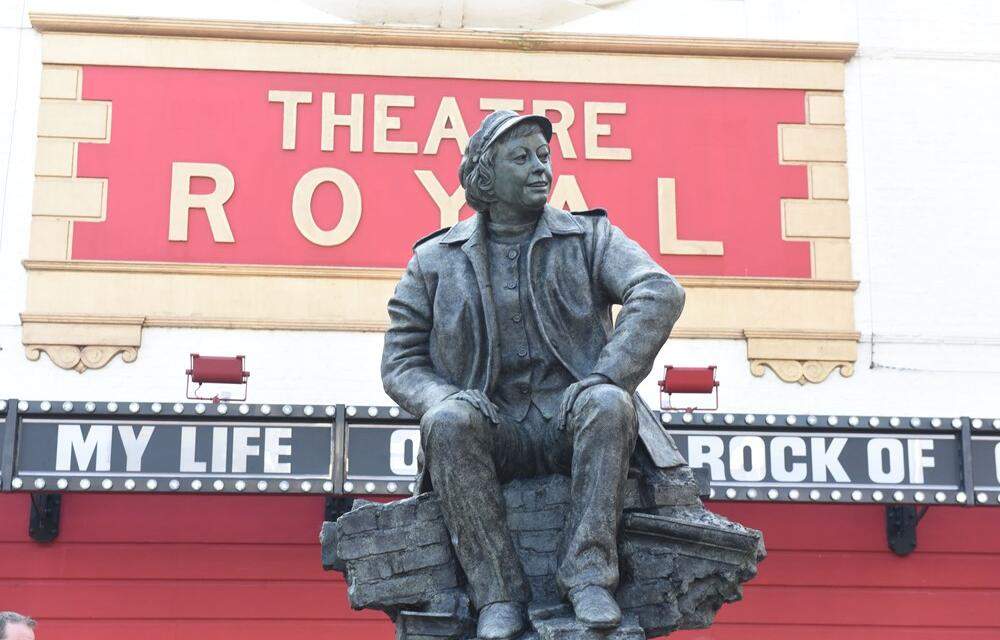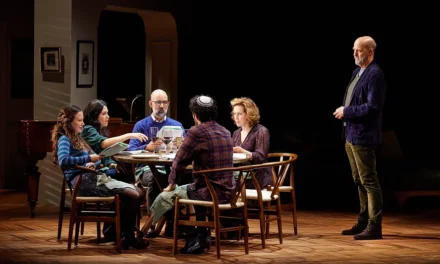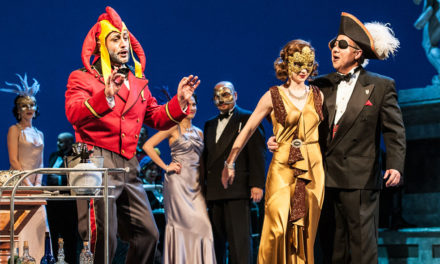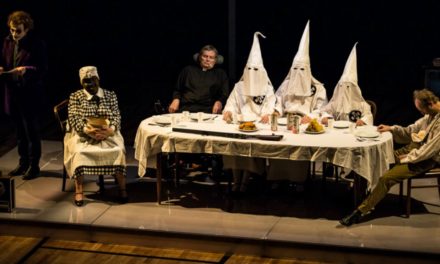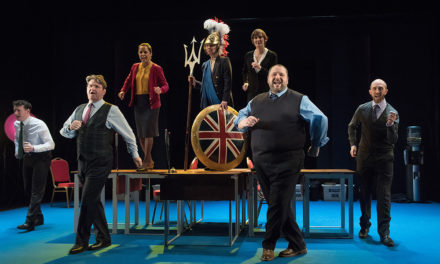Since 2015, a large bronze statue has stood outside the Theatre Royal Stratford East. Raised on a plinth above the heads of passing shoppers, ‘The Mother of Modern Theatre’ by sculptor Philip Jackson, depicts legendary director Joan Littlewood as she was photographed in 1974, sitting cheerfully on a pile of rubble in almost exactly this location. In spite of – or rather because of – my devotion to Littlewood, who died twenty years ago, it is hard not to feel ambivalent about this memorialization of her. For one thing, she would have hated it. Littlewood, who was born into a working-class family in south London 1914, bristled at any notion that she had joined the establishment.
Born to a seventeen-year-old shop-girl and raised mainly by her grandparents, Littlewood’s childhood taught her both working-class politics and an appreciation for culture – partly thanks to visiting the social reformer Lilian Baylis’ Old Vic. She won the London County Council scholarship to RADA, and traveled to Manchester on graduating, where she divided her time between work for the BBC and the local repertory theatre, and making agit-prop with the communist group Theatre of Action. This typified Littlewood’s relationship with the establishment: one foot may have been in, but the other was always out. She was also defiantly mercurial, refusing to be pinned down or defined by others. No statue could hope to capture all of this, but Jackson’s monumental rendition of Littlewood – stylistically similar to his depiction of the Queen Mother on the Mall – certainly misses the mark.
What’s more, the photograph that Jackson drew upon for his sculpture depicts Littlewood near the end of her time at the Theatre Royal. Her tenure in the theatre began in 1953, when she and her fellow members of Theatre Workshop took up residence in the badly decaying building, after almost a decade on the road. It was here that the company made its name with the first productions of what are now modern classics: Brendan Behan’s The Quare Fellow and The Hostage, Shelagh Delaney’s A Taste of Honey, radical productions of Shakespeare, and popular working class plays: Frank Norman and Lionel Bart’s musical Fings Ain’t What They Used T’Be and Stephen Lewis’s Sparrers Can’t Sing (which she also made into a film). But success couldn’t save Theatre Workshop; the company simply could not sustain the level of new productions and west-end transfers it needed to survive. Worn down by a lengthy war of attrition with the Arts Council and Newham Council over the theatre’s funding and plans to redevelop the local area, threatening the theatre with demolition or insolvency, Littlewood left the Theatre Royal surrounded by the rubble that her depiction now sits atop outside it. Today, further waves of gentrification have been visited on the local area, with many working-class people directly uprooted or priced out. Littlewood’s vision for a community theatre in Stratford East has been reduced to the proudly idiosyncratic Theatre Royal marooned in the anonymous landscape of redevelopment.
In spite of all this, I’m glad the statue’s there. For one thing, in stark contrast to Elizabeth Angela Marguerite Bowes-Lyon, last Empress of India, Littlewood earned her bronze. Among her peers, only Peter Brook can have any serious claim to be a more significant theatre artist. Littlewood was the guiding hand not only behind Theatre Workshop’s capacity to merge radical politics and popular theatre but its ambitious theatrical explorations of the political and cultural forces that brought mankind to the brink of global destruction in the twentieth century: Uranium 235 and Oh What a Lovely War!
The image of Littlewood sitting in the rubble aptly encapsulates both the commitment to relentless work and the artistic method that created these productions. She wrote in the script for a 1947 BBC radio program about Theatre Workshop’s life on the road, that:
the artist’s progress is no luxury tour. There is no smooth autobahn along which one rides to one’s objective. The path, if you can call it that, is a rough one, always mounting upwards, disappearing now and then in morasses and swamps, a perilous path twisting through barren places, littered with the bones of a dead enterprise.
Consciously or not, Littlewood was echoing Karl Marx here, who wrote that ‘there is no royal road to science, and only those who do not dread the fatiguing climb of its steep paths have a chance of gaining its luminous summits’. Littlewood also drew on Marx’s famous dictum that whereas ‘philosophers have only interpreted the world, in various ways; the point is to change it’ to qualify some rare praise for a fellow director. ‘Tyrone Guthrie was good’, she said, ‘but he didn’t try to change the world. We did’. Like Marx, Littlewood knew the intellectual and creative work that this required first-hand. She spent hours in Manchester’s Central Library teaching herself about acting from Stanislavsky, and absorbing constructivist and Brechtian scenography. She observed classes at Rudolf Laban’s school in the city. Her surviving notebooks are full of elements culled from these sources, repurposed to train her actors and create new productions. The ‘luminous summit’ towards which Littlewood’s ‘artist’s progress’ aimed was not only the perfection of a given aesthetic style, but the creation of a new and compelling critical vision that could change the world.
Although she was not a stranger to self-mythologizing, Littlewood’s poetic description of Theatre Workshop’s creative processes was not only metaphorically accurate. Eschewing the ‘smooth autobahn’ of theatrical careers that moved gradually from seasons in small, regional repertory companies to larger cities and thence to London, Theatre Workshop made its name by pursuing what was literally the ‘perilous path’ of finding work where they could get it. Tracking the company’s touring routes produces chaotic scribbles across the UK, interspersed with leaps to mainland Europe and Scandinavia. They performed in half-derelict theatres and village and town halls. They set up home temporarily in the abandoned outbuildings of a country house near Middlesbrough, whose owners, like many aristocratic families, could no longer afford the staff required to maintain it. On tour, they built not just scenery but stages and lighting installations from what they carried in a van. Once they even hiked up Bleaklow Hill in Derbyshire to salvage lighting equipment that was scattered across the moor after an American aircraft, which was carrying it for the entertainment of troops, had crashed (needless to say, they didn’t have to race to get there ahead of Peter Brook).
The approach to collective theatre-making that these conditions necessitated was possible because Theatre Workshop was – in the words of company member Harry Greene – ‘tactically trained’. Greene, who went on to become the first television handyman, offers an excellent example. He joined the company after a performance in Wales that he had taken his class of schoolchildren to when he heard that they were looking for someone who could act, drive and repair their van, and build scenery. These combinations of skills were the norm in Theatre Workshop. Many of its members had joined directly from wartime or military service, where improvised solutions and repairs – not to mention the purloining of equipment – were standard practice. Like Littlewood, they were also mostly from working-class backgrounds. They knew how to fix things that middle-class actors had never heard of.
Nonetheless, although Theatre Workshop did ‘make do and mend’, this is not a hymn to the virtues of Littlewood’s austerity. The company suffered great precarity and hardship and deserved considerably greater financial support and security. With the exception of Fings’ cheerfully romanticized spivs, tarts, and gangsters, Theatre Workshop also managed to avoid sentimentalized depictions of poverty. Their working class was characterized by a collective strength that never hardened into monolithic solidity because it was also divided by lines of gender, race, and sexuality across which it nonetheless frequently pulsed with solidarity. Theirs was a collective theatre, made not only about, but with and for the working class, rooted in the self-taught knowledge and skills of working-class people. When Littlewood could no longer sustain that project within the middle-class institution of the post-war British theatre, she left it, throwing her energies into new initiatives for creative liberation. Most famous among these was the ‘Fun Palace’, which she and architect Cedric Price imagined as a pop-up community laboratory and entertainment space.
Had Littlewood lived to be 106, she would have been delighted to see the toppling of Edward Colston’s statue in Bristol. It would doubtless have appealed to her not only as an image of collective strength and anti-racist solidarity, but as a thrilling performance. So how should we remember an artist who ‘founded her life’, as she once told her successor at Stratford East Philip Hedley, ‘on the rock of change’? When director Sean Holmes launched the experimental Secret Theatre collective at the Lyric Hammersmith in 2013, he remarked that her ghost was hovering somewhere over them. I’ve heard that ghost recently too, slipping between the pages of Alan Lane’s memoir A Club on the Edge of Town, about Slung Low’s conversion to a foodbank during the covid pandemic. Since 2014, Fun Palaces have also been revived annually by artists and community organizers. Littlewood’s life and work remain a rich resource twenty years after her death. Faced with her statue, she’d probably urge us to break it up, melt it down, and put it to use.
This post was written by the author in their personal capacity.The opinions expressed in this article are the author’s own and do not reflect the view of The Theatre Times, their staff or collaborators.
This post was written by Tom Cornford.
The views expressed here belong to the author and do not necessarily reflect our views and opinions.

